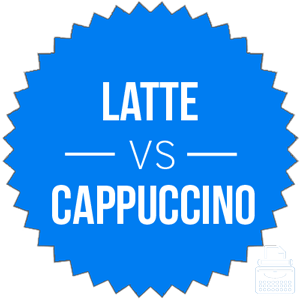Cafes the world over have expanded their menus to cater to ever more discerning coffee lovers. Where once you might have been lucky to find any options beyond regular and decaf coffee, today, most establishments are eager to offer a litany of specialty drinks that may include coffee only as a formality.
Two of the more ubiquitous drinks, lattes and cappuccinos, seem to differ only in name. Upon closer inspection, though, these two terms refer to distinctly different drinks.
What is the Difference Between Cappuccino and Latte?
In this post, I will compare cappuccino vs. latte and use each word in an example sentence. This way, you will be able to see each word as it appears in context.
Plus, I will show you a helpful memory tool that makes choosing cappuccino or latte much easier in context.
When to Use Cappuccino
 What is a cappuccino? Cappuccino is a noun. A cappuccino is a coffee drink made with espresso and steamed milk.
What is a cappuccino? Cappuccino is a noun. A cappuccino is a coffee drink made with espresso and steamed milk.
A classic cappuccino is roughly one part espresso to two parts foamy milk. In practice, many baristas mix the drink as one part espresso, one part steamed milk, and one part milk foam, since creating foamy milk is an exacting and difficult process.
Here are some examples of cappuccino in a sentence,
- With a milk steamer, you can create perfect cappuccinos from the comfort of your own kitchen.
- Andy ordered a vanilla cappuccino while he waited for his date to arrive.
Cappuccino is a loanword from Italian. According to Merriam-Webster, the word derives from the similarity in color between the drink itself and the traditional attire of a Capuchin monk. The drink became popular in America in the 1990s during the “Third Wave” of coffee.
When to Use Latte
 What is a latte? Latte is also a noun, and a latte is also a coffee drink made with espresso and steamed milk.
What is a latte? Latte is also a noun, and a latte is also a coffee drink made with espresso and steamed milk.
The difference between a latte and a cappuccino is in the proportion of espresso to milk. In a cappuccino, the ratio is roughly one part espresso to two parts foamy milk. The ratio of espresso to milk in a latte is roughly one to three, and may contain much less foam.
Here are some examples,
- A person could order a latte at any of thousands of cafes in America and receive a similar drink.
- The latte has become symbolic of urban elitism in some circles.
Like cappuccino, latte is also an Italian loanword. The original term was caffe latte, and translates to milk coffee.
Trick to Remember the Difference
 These words refer to different coffee drinks, so you should use them carefully. The main difference between them is in the amount and texture of the milk.
These words refer to different coffee drinks, so you should use them carefully. The main difference between them is in the amount and texture of the milk.
Latte vs. Cappuccino Check: Since a latte has much more milk than a cappuccino, and latte translates literally to milk, it should not be difficult to remember to use latte to describe the drink with more milk in it.
Summary
Is it latter or cappuccino? Cappuccino and latte are loanwords from Latin that refer to specialty coffee drinks.
- A cappuccino is roughly on part espresso to two parts foamed milk.
- A latte is typically one part espresso to three parts milk.
Be sure to use each word carefully, lest you accidentally order the wrong drink next time you visit a café.
Contents
